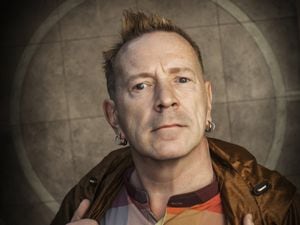Real life: The writing's on the wall
From spraying a subway wall to having famous fans, street artist Temper talks struggles, taking risks and finally making it big...

When we caught up with graffiti artist Temper, he was getting ready for a music video shoot with revered New York hip-hop legend Masta Ace. As you do.
The artist, otherwise known as dad-of-two Arron Bird, 44, is one of the UK's most accomplished graffiti writers. His work has been seen on Sprite cans and can be found in the personal collection of Sheikh Mohammed, Vice President and Prime Minister of the United Arab Emirates. You've probably seen his sculptures in The Cube in Birmingham if you've been – brass people with hearts for heads.
With a new secret project underway, we wanted to talk to Temper about his rise from a Wolverhampton street artist to someone that sells their work for tens of thousands of pounds to the rich and famous.
"I'm from East Park. I've got my feet on the ground," he tells us. "It's been hard work getting to where I am now, just to hone in on my craft. I've been the first in many ways, the first to go out doing live demonstrations around the country, before people knew how graffiti was done.

"When graffiti first emerged in the UK, I was just 11-years-old. Me, Goldie and a few crews were among the first in the UK to start doing it. Now, people get into it through college or through galleries. Back then it was just street culture. I do beat boxing, break dancing, graffiti – it was all just part of that initial culture. Hip-hop really came to this country in around 1981, and I was very fortunate to be a young lad when it started."
His love for graffiti started almost instantly: "The spray can is so natural for me to use, it was like finding your best friend. When I picked it up for the first time, it was hard for me to press the nozzle because I had little hands.
"The first time I painted a big wall, I didn't tell anyone that it was me that did it. And everyone in school was saying 'have you seen that burner?!' and I loved that reaction. It's been my best friend. Through having children, being broke or being lonely, no matter what happens I can always rely on it to be there for me. You can't see it – it's just a feeling. There are no boundaries. You can explore everything."
Temper has two children, and his daughter, now 22, was only a baby when he decided to produce art professionally. We laugh when he tells us about one particular moment when he realised that graffiti could be successful.
"Years ago, I painted the Molineux subway in Wolverhampton. I did it from top to bottom and all the way along. There were four lookouts on either end, to shout me if anyone came, so I could walk off. But after a while I realised that I was never going to get it finished, so told them to only shout me if it was the police coming.

"The first person to walk down the subway was a little old lady. She said, 'I've always wanted to know how this was done! Can I have a go?' So I gave her the can and let her fill in a little bit of the colour, and she said 'that's brilliant that is, that's made my day!' and carried on walking.
"The media were saying that the public hated it and it took the taxpayers money to get rid of it, but for every ten people that walked down that subway, there was eight of them that actually loved it. So for me, I knew that the public did like it. It was the first influence for me to go on and promote the art work freely knowing that it wasn't hated. It gave me the confidence to promote graffiti in a more positive way.
"I knew when my daughter was born that I needed to do it right then if I was ever going to do it. It was such a massive risk – I had a normal job in a wallpaper warehouse, a newborn baby, but I had this feeling that I wanted to take my art work to a different level. It was the biggest risk anyone could take, giving up their job. It was steady. But I had this urge, so I left it to set up a clothing label.
"That was really well received, but I lost money. My missus had to get a job at the chip shop so we could at least have a meal every day. We were in a high-rise flat, trying to get things up and running.
"But I stuck with it, and from there I started going out to do live demonstrations which turned into designs for brands like Airwalk, Kickers and Bench. The work was getting out there."
A huge breakthrough came when Temper was asked to create a campaign for Coca Cola – to brand up Sprite cans with his work.
"I remember Banksy walking across Clapham Common to me after I'd done the Sprite cans and saying, 'Flipping hell, how can anyone top that?' That's how big it was. It changed graffiti in this country, it was a big company taking a stand with the art form. "I was never into the illegal stuff. It's just that the environment I was in adapted itself to the art form. I've never painted a virgin wall, I've never painted on just a white wall and I'd have never damaged anything. All I've ever done is paint over old stuff that was already there.
"I started doing graffiti in the post punk era. There'd be things on the wall, racist slogans and messages, and I'd just paint over them. I was doing a public service! I wanted to get rid of all that trash. The media in the 80s were saying that councils, transport police and police were rising up against it, because it was everywhere – an epidemic really.

"The authorities were offering a thousand pounds to anyone willing to tell them whose names were whose. They really wanted to crunch it down. Sometimes, I'd do a piece overnight, and then the next day the sandblasters would come and just blast it away. It'd just be gone forever. There was a really bad picture painted about it all.
"Now I've got collectors all over the world. I know that Banksy has a great respect for my art, same as I have for his. But we're from different genres. My artwork hangs in some really serious private collections."
Though things are great for Temper, it hasn't always been plain sailing.
"I've been very blessed. I still have my ups and downs, there are times in your career where things are flat, and others when they really sky rocket. It doesn't just go upwards and that's it, it's up and down all the time. But I just keep on reinventing myself and being true to what I do, and it keeps getting me through."
And at that, we leave him to record the music video. We don't want Masta Ace to throw a Temper tantrum.
By Kirsty Bosley





